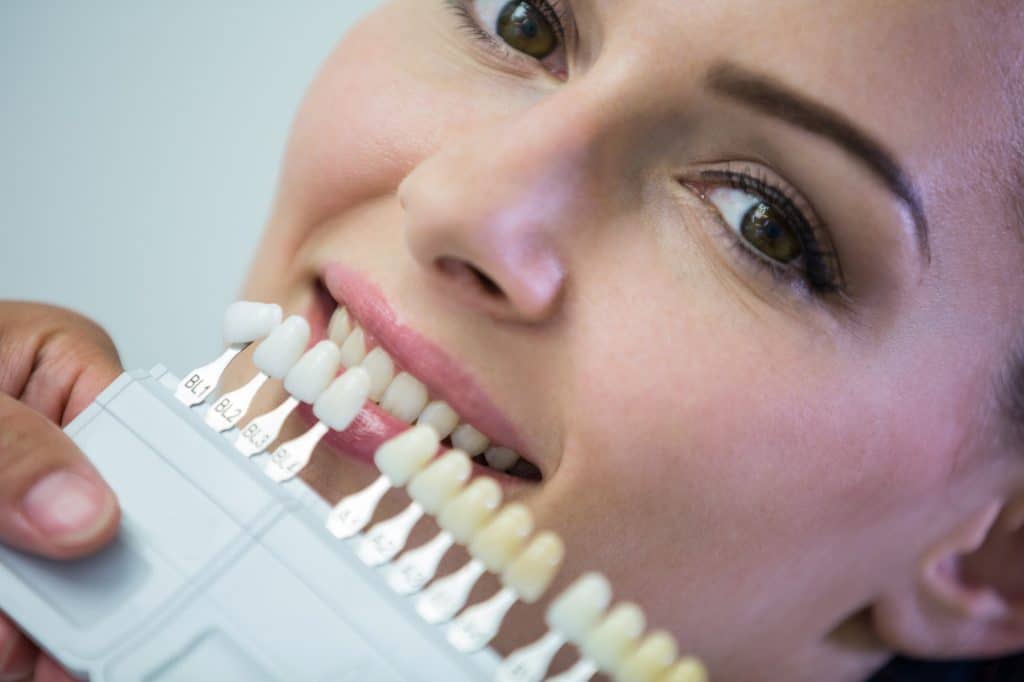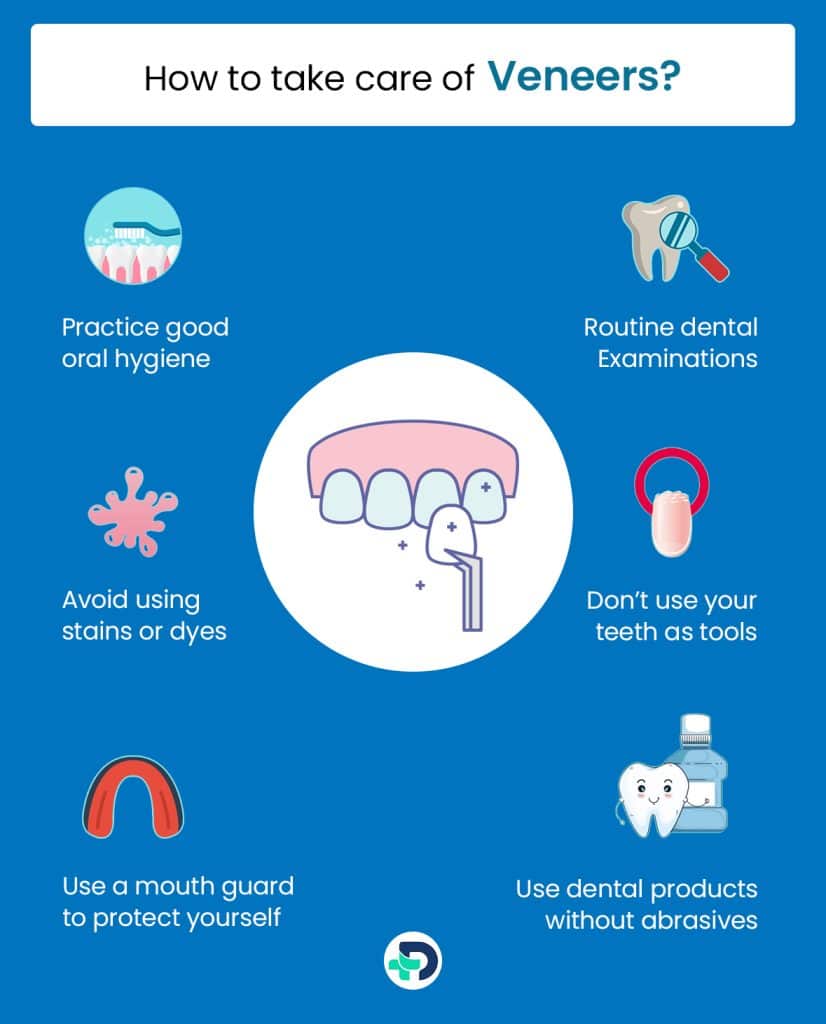A Complete Guide to Transforming your Smile with Dental Veneers

- Veneers
- 22 Aug 2023
Overview
What are Veneers?
Dental veneers are a standard cosmetic dental procedure that has received widespread recognition for their ability to create beautiful smiles. They are wafer-thin, delicately made yet durable shells that cover the front of the teeth, enhancing their color, shape, and overall appearance.1Overview| Researched based study from Yoursmilebecomesyou.com They are created to resemble the teeth’s natural look and feel and blend smoothly with the patient’s current dental structure. They are made from premium materials like porcelain or composite resin.
This article provides a thorough overview of dental veneers, illuminating their function, the materials used, application procedure, and advantages they offer. Before choosing them, we’ll also review the things to consider and respond to common questions and issues about this procedure.

Who needs?
Who needs Dental veneers?
Individuals with teeth that are:
- Discolored
- Chipped or worn
- Unevenly spaced or misaligned
- Irregular shape or size
- Resistant to teeth whitening
They may also be recommended for certain dental aesthetic issues where other treatment modalities may not be feasible. Below are the reasons which elaborates the indications for veneers.
Stained teeth
- Strongly stained or discolored teeth may not react well to conventional teeth whitening procedures from genetics, drugs, or excessive fluoride exposure. They can offer a solution by hiding intrinsic stains and regaining a brighter appearance.
Worn or broken teeth
- Teeth that are broken, cracked, or have worn edges can be unsightly and interfere with the symmetry of the grin as a whole. They can provide a smooth and authentic-looking surface by successfully hiding these flaws.
Uneven spacing or misalignment
- Veneers may be a good choice for those who want a more consistent and even smile. They can be a great choice for yet small gaps or slightly misaligned teeth. They can give the appearance that teeth are straighter without braces or aligners, but they cannot fix severe orthodontic problems.
Unusual size or form
- Veneers can aesthetically improve teeth that are naturally crooked or abnormally small compared to the rest of the smile. Dental experts can design a more symmetrical and balanced smile by adjusting the size and form.
Resistant to teeth whitening
- Due to the makeup of their enamel or certain dental disorders, some people may have teeth that may not respond well to teeth whitening procedures. Veneers can be a workable substitute for achieving a whiter, more appealing smile in these situations.
Dental veneers are primarily a cosmetic treatment. Thus, those with severe dental problems, including tooth decay, gum disease, or structural damage, should avoid getting them. Consulting a licensed dental practitioner to examine your teeth, understand your issues, and recommendations for the best course of action before considering veneers is crucial.1Need| Researched based study from Yoursmilebecomesyou.com ,2Need| Researched based study from Nlm.nih.gov ,3Need| Researched based study from Nlm.nih.gov
Preparation
Veneers preparation step-by-step guide
Consultation
- Make an appointment for a consultation with a cosmetic dentist as your first step. During this visit, you will discuss your worries, objectives, and aspirations for your smile.
Planning and analysis
- To better understand your oral health and decide whether veneers are right for you, the dentist will inspect your teeth and possibly take X-rays or impressions.
Preparation
- A thin surface of the tooth’s enamel, thin coating, must be removed to accommodate the prosthesis. This is to ensure they fit correctly and appear natural, this is done. The dentist will numb the region prior if necessary, although this procedure is typically painless.
Impressions or digital scans
- Your teeth will be photographed or scanned digitally to build an accurate representation of your mouth. These will be delivered to a dental facility, where trained specialists will create your personalized veneers.
Temporary veneers
- Your dentist may apply temporary veneers to your teeth while your permanent ones are being made. These will shield your teeth and give you a preview of your future smile.
Bonding
- During the final visit of the procedure your permanent veneers are fitted temporarily and checked for any discrepancies. If you have temporary ones, the dentist will carefully remove them before thoroughly cleaning your teeth. Then, they will attach them to the front of your teeth using a unique dental adhesive.
Adjustment and final touches
- The veneers will be adjusted to fit correctly and blend in with natural teeth. If necessary, they can trim or shape them. They will then be polished to give them a smooth, organic appearance.
Follow-up visit
- You could be asked to schedule a follow-up appointment after they’ve been bonded to ensure you’re satisfied with the outcomes and address any worries.1Preparation| Researched based study from Yoursmilebecomesyou.com
Types
Types of Veneers materials
Porcelain veneers
- Due to their dependability and natural appearance, they are the most typical and preferred option. Thin ceramic shells explicitly created to match the color, shape, and size of your teeth make up their construction.
- A highly realistic and aesthetically beautiful smile can be achieved with porcelain veneers because of their famed stain resistance and ability to mirror the light-reflecting qualities of genuine tooth enamel.
- Since they are made in a dental laboratory, the process usually requires two visits to the dentist.
Blended resin veneers
- They comprise a tooth-colored composite material that is an alternative to porcelain veneers.
- Contrary to porcelain veneers, direct application to the teeth can be completed in just one visit, speeding up the process.
- The composite material will be carefully applied to the teeth by the dentist, who will also carefully shape and sculpt it to provide the desired appearance.
- They may be more reasonably priced, and since they can be adjusted in the mouth, any necessary repairs or alterations can be easily made. In contrast to porcelain veneers, composite resin ones could be more susceptible to stains and yellowing over time.2Types| Researched based study from Nlm.nih.gov ,3Types| Researched based study from Nlm.nih.gov
Side effects
Side effects of Dental veneers
Irreversible procedure
- The removal of the enamel is a one-time, irreversible surgery. Thus, the tooth will always need a veneer or other type of repair to retain its aesthetic appeal. Be sure to give this irreversible change great thought before starting the treatment.
Sensitivity
- Temporary tooth sensitivity is typical and usually goes away within a few weeks, but it can occasionally last longer.
Cost
- They can be expensive, and the price varies depending on the quantity of veneers needed, the type of material, and the location of the dentist’s office.
- Discussing the cost and possible financing alternatives with your dentist is crucial to ensure it fits within your budget.
Replacement
- Although they are built to last, they are achievable. They could wear out, chip, or break over time, requiring replacement.
- They might last a shorter or longer time based on oral hygiene routines, behaviors such as tooth grinding, and the exact material used. Maintaining good oral hygiene and getting regular dental checkups can help increase longevity.
Staining
- While porcelain is exceptionally stain-resistant, composite resin veneers may eventually get increasingly stained and discolored, especially if exposed to certain foods, beverages, or smoke.
- Practicing good dental hygiene habits and avoiding consuming too many staining foods and drinks is essential to maintain the appearance.
Maintenance
- They need ongoing care and maintenance, like daily brushing and flossing, as well as frequent dental checkups.
- It’s crucial to adhere to your dentist’s oral hygiene guidelines and avoid practices that could harm the integrity.4Side effects| Researched based study from Nlm.nih.gov , 5Side effects| Researched based study from Nlm.nih.gov
Care

How to take care of Veneers?
Practice good oral hygiene
- Use a soft-bristled toothbrush and non-abrasive toothpaste to brush your teeth at least twice daily. Floss daily to remove plaque and food scraps along your gum line and between your teeth.
Use dental products without abrasives
- Select toothpaste and mouthwash that are designed especially for use with veneers or that your dentist recommends. Avoid using harsh chemicals or abrasive toothpaste since they might scratch or harm the surface of your veneers.
Avoid using stains or dyes
- Despite the excellent stain resistance of porcelain veneers, limiting the composition of substances that can discolor your natural teeth is still advisable. This entails consuming fewer cups of coffee, glasses of red wine, and other items containing solid pigments.
Don’t use your teeth as tools
- Please do not use them to open packages, bite your nails, chew on ice, pens, or other hard things. Although robust and excessive force might cause them to chip or fracture.
Use a mouth guard to protect yourself
- Wearing a mouth guard might help shield your teeth from harm if you play sports or grind your teeth at night. Ask your dentist about acquiring a mouth guard manufactured to order, fits well, and offers sufficient protection.
Routine dental examinations
- Keep up routine dental cleanings and examinations with your dentist. They can monitor the situation, evaluate your dental health, and quickly handle any worries or problems.6Care| Researched based study from Nlm.nih.gov
Any feedback on this article?
 This Articles content was accurate
This Articles content was accurate Very Informative Article
Very Informative Article I have a question or a comment
I have a question or a comment
 This article contains inaccurate content
This article contains inaccurate content This article was not helpful
This article was not helpful I have a question or a comment
I have a question or a comment
We appreciate your helpful feedback!
Checkout our social pages
References
-
Your Smile Becomes You
PORCELAIN VENEERS | Overview | Need | Preparation
-
National Library of Medicine
Porcelain veneers: An update | Types | Need
-
National Library of Medicine
Composite veneers: The direct-indirect technique revisited | Types | Need
-
National Library of Medicine
Interface toughness of a zirconia-veneer system and the effect of a liner application | Side effects
-
National Library of Medicine
Randomized clinical trial on indirect resin composite and ceramic laminate veneers: Up to 10-year findings | Side effects
-
National Library of Medicine
Patient Awareness of Soft-Tissue Irritants After Placement of Porcelain Laminate Veneers | Care






































